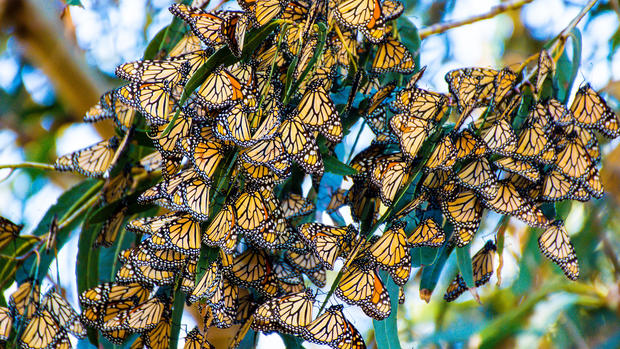The number of monarch butterflies spending the winter along California’s coast is at critically low levels — for the second year in a row. An environmental group said Thursday that the migration is at risk of collapsing.
Between 1994 and 2016, the eastern monarch population plunged more than 80% and a federal review found “a substantial probability” of collapse in the next two decades.
According to Xerces Society, a non-profit environmental organization focusing on invertebrate conservation, the monarch population during the 2018-19 winter was at an all-time low. This year’s numbers were no better.
Trending News
The organization counted 29,418 monarchs this year. While it is a few thousand more than 2018, volunteers visited more sites this year — meaning the number has functionally remained the same year-over-year.
In 1980, an estimated 4.5 million monarch butterflies wintered along the California coast. That number has plummeted, and 30,000 butterflies is the threshold below which the migration may collapse, Xerces said.
“We are disappointed by the numbers of year’s Western Monarch Thanksgiving count,” said Emma Pelton, the Xerces Society’s western monarch lead. “We had hoped that the western monarch population would have rebounded at least modestly, but unfortunately it has not. The silver lining is that the population didn’t shrink any further. There are still thousands of monarchs overwintering along the coast, so we can take heart that it’s not too late to act.”
Between 1994 and 2016, the eastern monarch population plunged more than 80% and a federal review found “a substantial probability” of collapse in the next two decades.
The monarch has been pushed to the brink of extinction by habitat loss and pesticide use, Tierra Curry, a senior scientist with the Center for Biological Diversity, told CBS News last March. She fears climate change could finish the job.
Monarchs return to the same sites — and sometimes even the same trees — each year, so protecting their overwintering habitat is crucial for their survival.
“We must protect all remaining overwintering sites in order to save our monarchs,” said Sarina Jepsen, director of the Xerces Society’s Endangered Species and Aquatics Program. “This is an urgent issue that needs to be addressed by federal, as well as state and local government in California.”
“In the United States, monarchs are threatened by climate change because of more severe storms when they’re migrating in the spring and in the fall,” she said.
The bigger storms, Jepsen said, “Blow them out of the air. Disrupt the migration. Cause them to get stuck in places. Or, if it’s too warm, then they stay north too long and then it gets cold and then they die.”
The U.S. Fish and Wildlife Service is currently considering adding the monarch butterfly to the Endangered Species Act. It will issue its decision in December.
Xerces Society has worked with researchers to identify two strategies to improve the butterflies’ odds of recovery: protection and restoration of their winter habitat and increasing the availability of early emerging native milkweeds, where they breed.
“Without immediate action I fear we will lose these animals from the western landscape,” said Scott Black, executive director of the Xerces Society. “With them, California will also lose out on tourism in places like Pacific Grove and, across the West, we will lose the ability for our children to experience the majesty of the monarch migration.”


